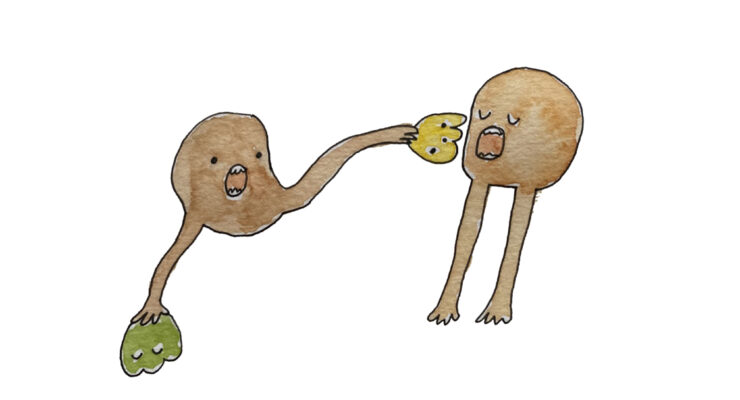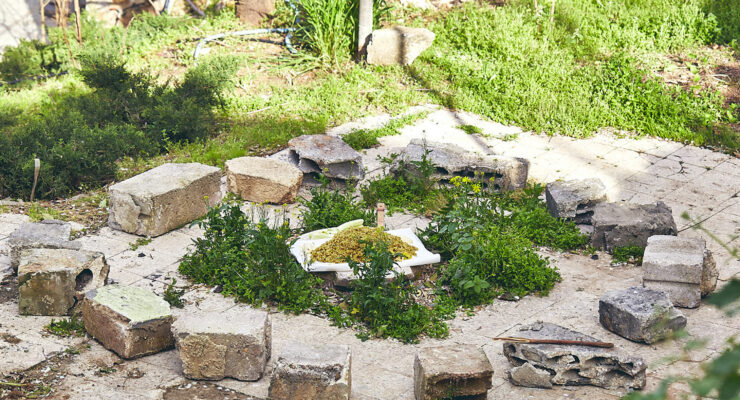“Scottish cuisine sort of got absorbed”
'Gathered' is a photographic exploration by Jack Mercer into the people and places that are behind some of Scotland's most iconic foods and drinks. The book is the result of working with five different producers to create photographic essays that use portrait, still lifes, documentary and landscape photography to create a detailed visual representation of their work. Along with the photographs of each producer, each story ends with a recipe created by ‘That’s Yer Dinner’, a Glasgow run supper club, that showcases the produce in all its glory. Scottish correspondent Steph Marsden spoke to Jack Mercer and Grant Reekie from 'That's Yer Dinner' about the project and their collaboration.
What was the inspiration for the project?
My parents owned a food shop down south that specialises in British grown and sourced produce, so I’ve always been around food, and I’ve worked as a fishmonger before. I wanted to explore Scottish food and the people behind it in order to try to move away from the global stereotype of British and Scottish food as being stodgy shite, which it’s not! Well – some of it is, however, a lot of it is not! I also hope to encourage people to eat more locally and seasonally as well, a better, more sustainable way of eating.
How did you go about deciding who you were going to profile?
It was a long journey, finding people and getting them to agree on times for the shoots. I knew that I wanted traditional Scottish producers and produce to be in it. Luckily, I discovered that a lot of creative people in Scotland have connections with people in food – one technician knew a chef that knew a forager; another knew a distiller. It took a lot of Facebook messages! I ended up profiling a distiller, deerstalker, fly fisherman, a traditional watermill and a forager.
How important was the photography in telling the stories of the people?
As a photographer, having specialised at Glasgow School of Art, it was a huge part for my final degree project, but I wanted to set it out like visual essays so the project tells a story in a creative way, using portrait, landscape, still life, as well as some set-up shots for the food. The project is all contextualized in a book, with a foreword and a bit of text written by me about each of the producers. Each chapter is finished with a corresponding recipe by Grant.
To Grant: at what stage in the process did you get involved?
Grant: It was towards the end of the project. Kinning Park Complex did a series of lectures, one was about food culture and transnational identity. I was discussing my experiences researching Scottish food there, and somebody who knew Jack was one of the other participants in that workshop and had mentioned it to Jack, and then we started chatting on Instagram. He’d been looking for a mill or something similar or was because I’d been ‘banging on about’ peasemeal?
Jack: You’d been banging on about peasemeal! Yeah, I did want to try and get as many food groups as possible, so it did help!
Grant: The reason I’d been ‘banging on about’ peasemeal a lot is because of my interest in looking back at the historic Scottish diet…what it actually was as a Scottish cuisine before it got lost to modern culture. I guess Scottish cuisine sort of got absorbed into the general British beige ready-meal culture in the ’70s. But before that, and the further back you go, the more distinct Scottish food was from British food. Because I like to cook locally and sustainably as much as possible, we’d been looking to source pulses to use in our supper club. Because although there’s a lot of grains in Scottish cooking, a lot of oats and barley, as staples, I wanted to find a Scottish substitute for polenta in a dish we made with liver, and peasemeal is made from roasted and then ground yellow split peas. Trying that change was great and really worked for us. Then, once you look further into the story of it, there’s just one guy that’s making peasemeal up at Golspie Mill, a sheep-shearing New-Zealander that’s travelled across the world, met a Scottish girl, and ended stuck up in a mill in Sutherland! Michael Shaw is the last person…pretty much in the world who is actually producing peasemeal!
I’d never heard of peasemeal before, but when I was talking about it at the Kinning Park workshop, there was this older Glaswegian woman there, and she started singing this song, (almost like a nursery rhyme) …about eating pease brose at school. I thought it was great that there’s still a living memory of it.
Did you make any surprising or interesting discoveries? Are there any things that stood out that you didn’t know about traditional kinds of production?
Jack: Because I had to research everything before I went out, I had found out quite a lot already…
Grant: Going on a deer stalk must have been pretty eye-opening?
Jack: Yeah, for the one deer we caught, I think he went on five different stalks, and for three of them, we had to wake up at half-three in the morning! The hard graft that goes into things was surprising. I’ve also noticed how little gets wasted by small-scale Scottish producers and how considered people are about stuff – for example, in the whisky distillery a lot of the byproduct is used to feed the sheep on the island of Raasay. Everyone’s just very open as well… I was also always bumping into a lot of people from Glasgow!
Grant, I know you’ve been doing some travelling and cooking around the world in recent years… were you interested in historic Scottish ingredients and heritage before, or did travelling encourage you to think more about Scottish heritage and food?
Grant: I’ve always been interested to an extent. I used to cook globally, I’d say and at home, I cook a lot of Asian food and Italian food, but I’d always wanted to cook more Scottish food and I’d felt like something was missing there. When you’re a chef you’re always like “I wish I was French or Italian you know, they’re the guys that have got a lauded culinary heritage”, but it’s like anything, just because we’re the ones that get less time in the limelight, it doesn’t mean our stories are actually any less interesting. And the more you think about it, we’ve got all of this amazing produce…what the missing step here is, is the recipe!
It was actually a conversation with a taxi driver, which started me off on this journey. I think often there’s an affinity between taxi drivers and chefs because we both work antisocial hours. He asked me: “where would you send somebody in Glasgow to get a Scottish meal?” Talking about mince and tatties and stuff like that, I realised I genuinely did not know. There are a few places like The Gannet and Cail Bruich in Glasgow, that use good Scottish ingredients but does them in a very modern, fine-dining style, however, there is a lack of places that do traditional Scottish food in the way that somewhere like St. John in London does traditional British food. Somebody should be doing this – it’s preservation of the culture. As much as anything, giving people something to be proud of. I think culinary heritage is something that is missing a bit from Scottish culture because people tend to take the piss out of ourselves – but there’s more to us than Irn Bru and f*cking tablet!


Calve’s Liver with Peasemeal (left), Venison, Skirlie and Blackberries (right)
How do you view photography as a storytelling narrative?
Jack: I’ve always used photography to tell a story in my work, I do some fashion and documentary. Normally, in documentary, I wouldn’t use just a single image, usually, it would be a series of images telling, or attempting to tell a story. It’s always been the best way for me to tell a story or show people other parts of life.
How do you think you can tell stories through a plate?
Grant: I think it’s interesting to tell stories through what you’re putting on a plate, as well as the way you present it. It makes it more interesting than ‘we always cook what’s in season’, storytelling kicks things up a notch. We’ve done that in a few ways throughout different supper clubs and events that we’ve done. As well as researching ingredients, such as the peasemeal we’ve been using, something we’ve been working on for a while is a dish with octopus and langoustine. We didn’t really used to get a lot of octopus in Scottish waters, it’s a little bit too cold, and too far north…but as sea temperatures rise they’ve migrated northwards and it’s actually a big problem for creel-fishers, as the octopus can squeeze into the creels and basically go in and eat the langoustines from the inside out! So the fishermen pull up a creel and there’ll just be empty langoustine shells inside it! It’s a great story, and when you put these two things together on a plate, you can then say why, it’s a story about one is making the other one harder to get hold of, a story about how ecology is changing. Another thing we did recently for a Burns supper event, was a homemade crowdie made with milk from Mossgiel Farm, where Robert Burns was said to have worked. These were moulded into ‘sleekit wee beasties’ like sugar mice, in order to pay homage to the Burns poem ‘To a mouse’, and bring the poem and the man and the place together.
Are you planning to do any specific collaborations apart from the recipes? Are you going to try and showcase the two together via the Supperclub?
Jack: We have talked about it. It would be good to!
Grant: Yes. As ever, it’s a matter of time! The supper club allows me to be a little more experimental than in my residency at Inn Deep… it allows me and my brother to be a little bit more off-piste – pushing forward and experimental! Although I’m not really fond of the name ‘supper club’ – it’s a bit soul-cringingly middle class – it allows us to break some of that separation between what’s going on back of the house and what’s happening in the front of house. I like doing that because there’s not many of us doing it in Glasgow at the moment. It’s a nice way to have people eating together.
For more information on Jack and his Gathered project visit jackgmercer.com.
Brothers Grant and Gordon Reekie run That’s Yer Dinner run pop-up supper clubs in Glasgow showcasing farmed and foraged Scottish ingredients.
_
This article was written by Steph Marsden, our Scotland correspondent and founder of food/play/food.











